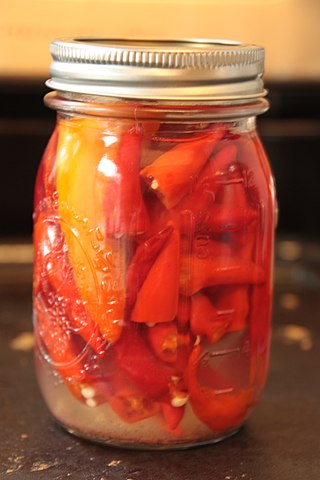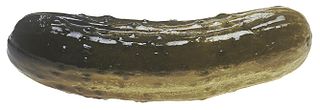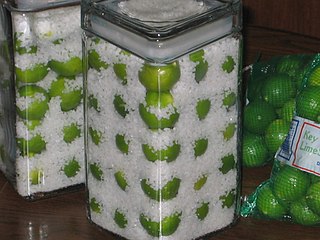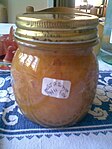
A condiment is a preparation that is added to food, typically after cooking, to impart a specific flavor, to enhance the flavor, or to complement the dish. A table condiment or table sauce is more specifically a condiment that is served separately from the food and is added to taste by the diner.

A chutney is a spread typically associated with cuisines of the Indian subcontinent. Chutneys are made in a wide variety of forms, such as a tomato relish, a ground peanut garnish, yogurt or curd, cucumber, spicy coconut, spicy onion or mint dipping sauce.

Mixed pickles are pickles made from a variety of vegetables mixed in the same pickling process. Mixed pickles are eaten much like other pickles: in small amounts to add flavor and to accent a meal. Mixed pickles appear in many different world cuisines.

Rémoulade is a cold sauce. Although similar to tartar sauce, it is often more yellowish, sometimes flavored with curry, and often contains chopped pickles or piccalilli. It can also contain horseradish, paprika, anchovies, capers and a host of other items.

Chow-chow is a North American pickled relish.

Pickling is the process of preserving or extending the shelf life of food by either anaerobic fermentation in brine or immersion in vinegar. The pickling procedure typically affects the food's texture and flavor. The resulting food is called a pickle, or, if named, the name is prefaced with the word, 'pickled'. Foods that are pickled include vegetables, fruits, mushrooms, meats, fish, dairy and eggs.

Branston is an English food brand best known for the original Branston Pickle, a jarred pickled chutney first made in 1922 in the village of Branston near Burton upon Trent, Staffordshire by Crosse & Blackwell. The Branston factory proved to be uneconomical, and production was moved to Crosse & Blackwell subsidiary, E Lazenby & Sons in Bermondsey, London, where it invested in new buildings in 1924 and 1926, which remained in use until 1969.

The generic term for condiments in the Filipino cuisine is sawsawan. Unlike sauces in other Southeast Asian regions, most sawsawan are not prepared beforehand, but are assembled on the table according to the preferences of the diner.

A pickled pepper is a Capsicum pepper preserved by pickling, which usually involves submersion in a brine of vinegar and salted water with herbs and spices, often including peppercorns, coriander, dill, and bay leaf.

A pickled cucumber – commonly known as a pickle in the United States and Canada and traditionally a gherkin in Britain, Ireland, South Africa, Australia, and New Zealand – is a usually small or miniature cucumber that has been pickled in a brine, vinegar, or other solution and left to ferment. The fermentation process is executed either by immersing the cucumbers in an acidic solution or through souring by lacto-fermentation. Pickled cucumbers are often part of mixed pickles.

Jangajji (장아찌) or pickled vegetables is a type of banchan made by pickling vegetables. Unlike kimchi, jangajji is non-fermented vegetables, usually pickled in soy sauce, soybean paste, or chili paste. Jangajji dishes are usually preserved for a long period of time, and served with a drizzle of sesame oil. Preserved foods like jangajji were developed to attain a certain level of vegetable consumption during the long, harsh winters on the Korean peninsula.

Pickled fruit refers to fruit that has been pickled. Pickling is the process of food preservation by either anaerobic fermentation in brine or immersion in vinegar. Many types of fruit are pickled. Some examples include peaches, apples, crabapples, pears, plums, grapes, currants, tomatoes and olives. Vinegar may also be prepared from fruit, such as apple cider vinegar.

Anchovy paste is a fish paste food product prepared using anchovies as a primary ingredient. It is used as a condiment and as an ingredient in various dishes, such as Scotch woodcock, and is a mass-produced product. It has been used for centuries to provide flavor to foods and as a source of nutrients, and it is a part of the cuisines of Great Britain, Italy, the Philippines and Vietnam. It is a major export product of Morocco.
Indian relish is a spicy relish used as a condiment or side dish. It consists of variety of vegetables and fruit that can include chopped bell peppers, sweet onion, garlic, tomatoes, sour apples, mustard, cloves, white wine vinegar, crushed red pepper flakes, ginger, and sugar. Recipes for Indian relish started appearing in cookbooks during the 1700s. Indian relish was imported from India and became popular in England and Scotland during the 18th century.





















